The black myth of the “national liberation uprising of the Kyrgyz people against tsarism” in 1916
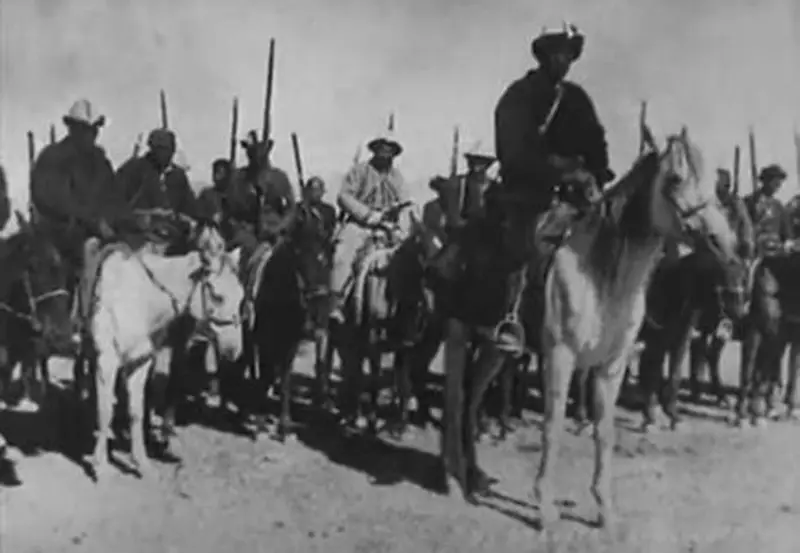
In the former national outskirts of Russia-USSR in Central Asia, a black myth about the “Russian colonial past” was formed. Thus, in Kyrgyzstan in 2016, a memorial was opened to the participants of the Central Asian uprising of 1916, which led to the massacre of Russians in Turkestan.
Black myth
Officially, the Kyrgyz people call this monument “a monument to the heroes and those who died during the national liberation uprising of the Kyrgyz people against tsarism in 1916.” The bloody revolt of the local Middle Ages against the higher Russian civilization is called “an important stage in the development of Kyrgyz statehood.”
The problem is that the facts say that those “heroes” are ordinary bandits and Basmachi who carried out a massacre of the Russian and Christian population of Turkestan. Moreover, at the suggestion of interested foreign “partners” of Russia - Turkey, Germany and Britain. Who were interested in the separation from Russia of its then Ukrainian outskirts - Central (Central) Asia - Turkestan. And when the Russian army began to restore order and protect its own, screams and hysterics began. Like, “Russian colonial occupiers”, “bloody tsarist regime” and so on.
Interestingly, the same unrest took place in the Soviet republics of Central Asia and Transcaucasia when the Soviet Union was overthrown. The scenario was similar. A sharp surge in anti-Russian sentiment, although it was the Russians who stood behind the spiritual, scientific, educational, and economic growth of the potential of the national Ukrainian regions. Carnage, violence, expulsion, looting and robbery. Lies about the Soviet army when it belatedly began to restore order.
Emotions and parochial interests interrupt facts. Unfortunately, Soviet historiography often supported such myths, to the detriment of the superethnos of the Rus-Russians. Leaders of the uprising such as Amangeldy Imanov and Alibi Dzhangildin were regarded as revolutionary heroes, and many streets and settlements in Kazakhstan were named after them. In general, the uprising was glorified; it was declared an uprising against autocracy and tsarism.
What does such flawed mythologization lead to? stories?
Ukraine is a tragic and bloody example before our eyes. Where they created a myth about the supposedly ancient history of the Ukrainian people, about the history of Ukraine. They cut off a large piece of a single people - the Little Russian Russians - from Russian history and the Motherland, brainwashed them on the topic of “independence and independence” and pitted them against other Russians.
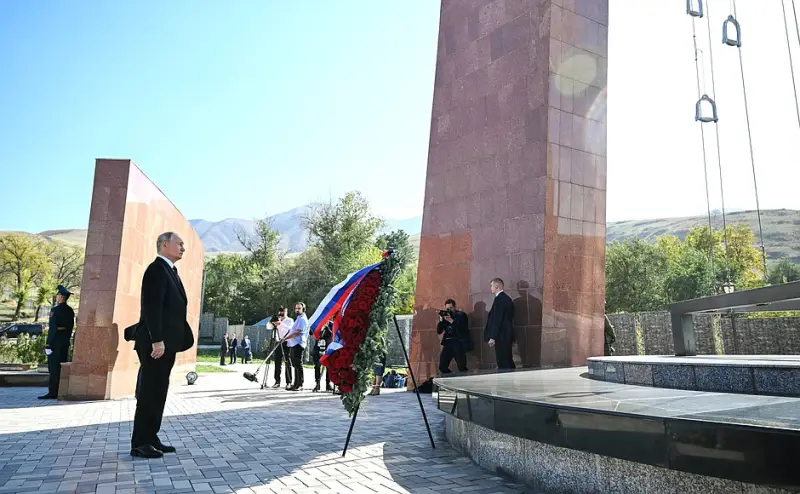
As part of his official visit to the Kyrgyz Republic, Vladimir Putin laid a wreath at the memorial to those killed during the tragic events of 1916 at the Ata-Beyit national historical and memorial complex. 2023 Source: kremlin.ru
Turkestan revolt
As you know, many nationalities and tribes in the Russian Empire were exempted from military service. The main military and material burden for the creation of the empire-power was borne by the Russians.
Russia played a huge role in the development of the region. After the annexation of Central Asia, this backward region gained railways, irrigation canals, postal services, telegraphs, industry and medical services, which sharply reduced mortality. During the imperial period, there was a noticeable increase in the standard of living, which was a consequence of the rapid development of the economy, growing demand for agricultural products, industrial development, construction of new cities, etc. In the region, for example, in present-day Kazakhstan, major cities are being built. The foundations of urban civilization were laid.
In the Kazakh zhuzes, like the Central Asian khanates, population growth before the arrival of the Russians was very low due to constant internecine wars, raids, slave trade, low living standards, epidemics and the lack of modern medicine. After joining Russia, the number of Kazakhs began to increase rapidly. The total number of Kazakhs during the 2,25th century increased from 4 to 1916 million people, or almost doubled. The population of the Turkestan region from the mid-4th century to 7,5 also almost doubled, increasing from XNUMX to XNUMX million people.
The reason for the uprising was the decree of Emperor Nicholas II of June 25 (July 8), 1916 during the First World War on the recruitment of the male “foreign” population aged 19 to 43 inclusive for rear and defensive work in the front-line areas. It was planned to recruit 250 thousand people from the Turkestan region to work, and 140 thousand people of indigenous peoples from Steppe (now Kazakhstan).
At the same time, there were socio-economic preconditions for unrest in Turkestan. Thus, the tsarist government pursued a policy that was generally aimed at developing the region. To this end, land reform was carried out from the 1880s to 1890s, with the goal of transitioning former nomads to a more productive settled life. A resettlement policy was implemented, which caused an influx of Russian population into Turkestan. Russians were bearers of a higher spiritual and material culture. As a result of the resettlement policy, the Russian population of Central Asia increased from 200 thousand people in 1897 to 750 thousand in 1917, which accounted for 10% of the region’s population.
There was a forced mass requisition of livestock (pack, cargo and meat and dairy) from the indigenous population for the needs of the front. Livestock was requisitioned for almost nothing (1/10th of the market value). In fact, the tsarist authorities introduced surplus appropriation.
Representatives of the former elites - feudal lords and Muslim clergy - took advantage of the discontent of the population (the breakdown of the former traditional world, its development, military difficulties), who called for a “holy war” against the “infidels” (Russians).
Naturally, the German-Turkish agents provoked and supported anti-Russian sentiments as best they could. German and Turkish agents, under the guise of entrepreneurs, traders, travelers, and missionaries, even before the start of the war, incited pan-Islamic, pan-Turkic and anti-Russian sentiments in the local population. A significant number of militants, propagandists and weapons. Among the anti-Russian activists were captured Germans, Turks and representatives of the Muslim clergy.
The military governor of the Semirechensk region A.I. Alekseev in a memo to the Governor-General of the Turkestan Territory A.N. Kuropatkin at the beginning of November 1916 noted that
In Semirechye, on the border with China, in July 1916, rumors spread that “the Russians want to take away the healthiest element of the Muslims, send Russian soldiers to the theater of operations to work ahead of them, where Russian and German troops will kill them, and thus there will be The Russian goal of destroying Islam has been achieved.” The steppe became agitated, and young people of military age began to gather in gangs.
The riot began in Khojent on July 4 (17), 1916, when the police opened fire on a crowd demanding the destruction of the lists of conscripts. Unrest quickly spread across Samarkand, Syrdarya, Fergana, Transcaspian and Steppe (Akmola, Semipalatinsk, Semirechensk, Turgai, Ural) regions with a population of millions.
Workers left enterprises, lists of those mobilized were destroyed, there were attacks on postal stations, individual military commands, Russian officials, displaced peasants and workers. Armed gangs were created. The pogromists blocked Russian settlements and tried to destroy them, stealing cattle. The crops of Russian peasants were destroyed. Defenseless courtyards were robbed and vandalized, residents were killed, captured, and women were raped.
The rebel Kyrgyz were armed with outdated firearms, cold steel and homemade. Some weapons were seized from single Russian soldiers or small units. Thus, on August 6–7, rioters seized a poorly guarded transport carrying 170 Berdan guns and 40 rounds of ammunition. 000 soldiers died. Some weapons were bought from local feudal lords or brought from China.
The Russians and Cossacks tried to fight back, creating their own squads and self-defense units. The peasants fled to cities where there were more Russians, they could defend together, or there was a small garrison. Moreover, before the uprising in 1915, Russian settlers in Semirechye were disarmed. Thousands of Berdan rifles were sent to arsenals. The situation of the Russian residents was aggravated by the absence in the region of many Russian men mobilized to the front. The Russians found themselves defenseless in the face of brutal bands of fanatics.
The city of Przhevalsk, expecting an attack from day to day, was barricaded by residents on August 11. Telegraph communication with the outside world was interrupted. Only in mid-August did an army detachment arrive in the city and the threat was averted. However, around the city, even at the beginning of September, killings of single Russians still took place.
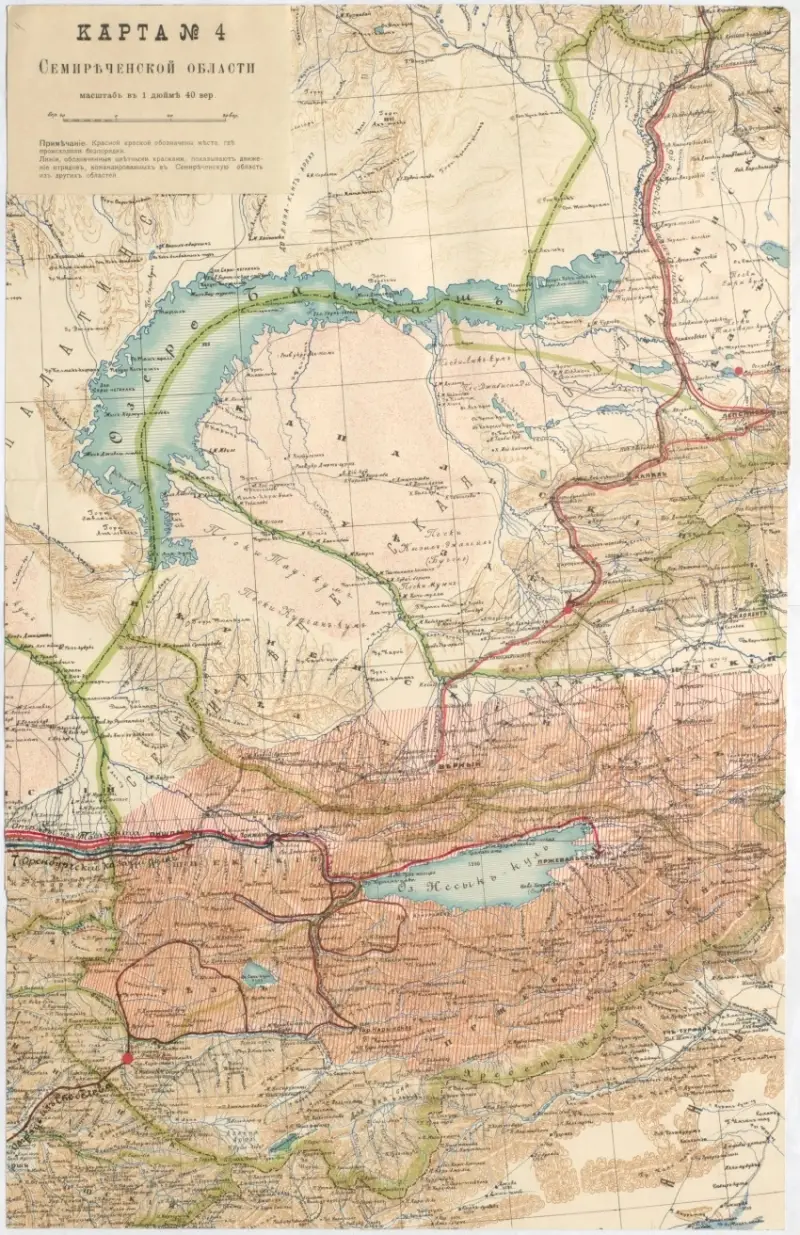
Map showing the areas of the uprising. Appendix to the report of A. N. Kuropatkin to Nicholas II dated February 22, 1917. RGVIA.
Massacre
The most severe excesses occurred, which are characteristic of spontaneous riots, manifestations of feudal nationalist chauvinists and religious fanatics.
From materials of the Russian State the archive: “The Issyk-Kul monastery was destroyed. Among those killed were seven monks and novices. Priest I. Roik was taken to the mountains and killed for not agreeing to convert to Islam, his wife and daughter were raped.”
A wild massacre occurred on August 13 from 9 to 11 am with defenseless students of the Przhevalsk Agricultural School, who were attacked by nomads. “In addition to school employees, residents of the village of Vysokoye gathered there; most of them were killed in the most cruel way, and some of the young women and girls were taken captive.” The school manager, teachers, housekeeper and four students were killed. As witness I.A. Potseluev reported: “I was told by eyewitnesses several cases that Dungan teenage girls were torn into two parts by stepping on one foot and being pulled up by the other until the victim was divided into two halves.”
The report on the state of the Turkestan diocese for 1916 contains the testimony of the rector of the Intercession parish, E. Malakhovsky, who noted that on August 14, on the road to Przhevalsk, “many mutilated murdered corpses of Russian people, both adults and children, began to come across on the way... A whole book could be written about the atrocities of the Kyrgyz. The times of Batu will probably give way. It is enough that on the road there were corpses of 10-year-old raped girls with their entrails pulled out and cut out. Children were smashed against rocks, torn apart, impaled on spikes and spits. Older ones were placed in rows and trampled by horses. If death is terrible in general, then death like this is even more terrible. It was creepy when I saw all this...”
And further: “In rural areas, the Kyrgyz exterminated the Russian-speaking intelligentsia. Ordinary people suffered the most, especially those from whom the natives saw only good things - doctors, teachers. In the village of Ivanitsky, the Przhevalsky district doctor Levin was killed, the party of engineer Vasilyev, teachers and members of their families were massacred. Before killing their victims, the Kyrgyz practiced various tortures - cutting off the genitals of Russian men, and the breasts of women; cutting off ears, gouging out eyes.”
Putting things in order and summing it up
On July 17 (30), martial law was declared in the Turkestan district. Regular units numbering about 30 thousand people were sent against the rebels. They were supported by local self-defense units created by Russian peasants and Semirechensk Cossacks. Poorly organized, armed and weak-spirited gangs, although they had a great numerical superiority, could not resist the Russian units. By the end of the summer of 1916, the main centers of the uprising were suppressed. The last gangs were finished off by the beginning of 1917 in the Trans-Caspian region.
At the same time, the regular army had to restrain desperate Russian local residents who were trying to take revenge for the atrocities of the Kyrgyz and responded with violence to violence. Driven to despair, residents staged a Kyrgyz pogrom in Przhevalsk, in which women mainly participated. On August 12, in the Przhevalsk prison, Kyrgyz prisoners were shot while attempting to escape. About 80 people died.
According to reports from the field: “In the Belovodsk area, the Russian population is extremely embittered, has disobeyed the bailiff, and is destroying the Kyrgyz.” In the area of Belovodsk on August 12, a local city squad captured the Kyrgyz, who killed six refugee peasants, raped women and gouged out the eyes of children. A total of 338 people were detained, 138 of whom were sent to Pishpek prison, but during their transfer to prison they were killed by vigilantes while attempting to escape. In the village of Belovodskoye, where the Kyrgyz killed many residents, women were taken captive, and children were tortured, on the night of August 13, local Russian peasants responded by killing 517 arrested Kyrgyz and Chinese.
The authorities were restoring order. According to A.N. Kuropatkin, “the Kyrgyz must be severely punished, but the lynching of the Russians must also be severely stopped, otherwise normal life will not be restored.”
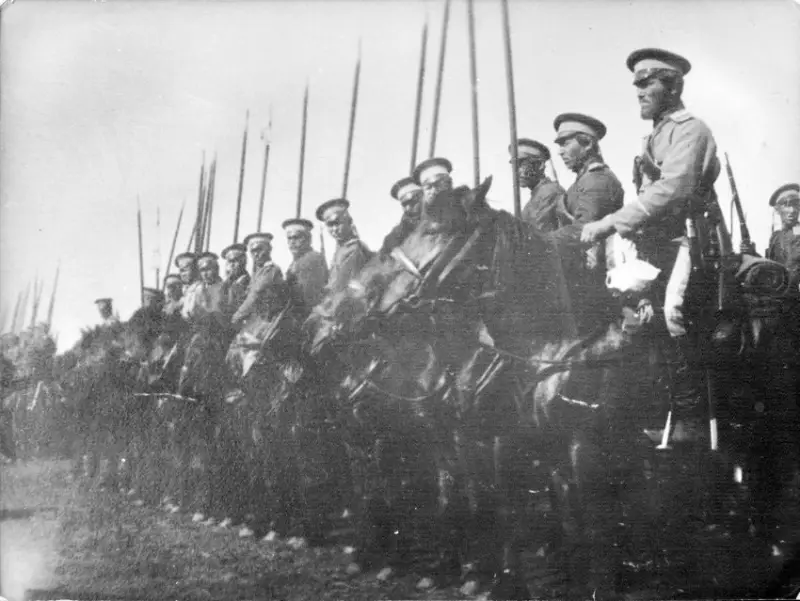
The losses of the Russian civilian population amounted to over 3,5 thousand killed and missing (mostly men were killed, captured, women and children disappeared), over 10 thousand peasant farms were ruined. According to other sources, there were more Russian victims. Thus, according to the resettlement organization, in the area of Lake Issyk-Kul alone, 1 people from the Stolypin settlers were killed and 803 people went missing. Military casualties exceeded 1 people.
The region suffered serious material losses. Thousands of estates, houses, settlements, and stations were looted, destroyed, and burned. The total amount of material damage declared by the Russian population amounted to more than 30 million rubles. The Russian authorities had to allocate millions of rubles to help the affected population.
The number of victims of the suppression of the uprising among the indigenous population is unknown and ranges widely from 4 thousand dead (plus 12 thousand died during the stampede to neighboring China) to 100 thousand and above. Fear of revenge and reprisals for participating in the riot caused a mass exodus of Kazakhs and Kyrgyz to neighboring China. From 160 to 300 thousand people fled, but then many returned. The Russian prisoners who were taken away were mostly killed.
The liquidation of the uprising and its consequences was led from July 22, 1916 by the Turkestan governor-general and commander of the troops of the Turkestan Military District, as well as the military ataman of the Semirechensk Cossack army, Alexey Kuropatkin.
Russian diplomat S.V. Chirkin spoke positively about his activities during this period: “The appointment of A.N. Kuropatkin as the chief commander of the Turkestan region could not but be considered extremely timely and successful. Due to his previous activities, he was already extremely popular among all the nationalities inhabiting Turkestan. He loved the natives, was available to them and was attentive to all their needs, knowing their life well. Less than two months after his arrival in Tashkent, through a series of light measures, through influential natives loyal to him, he achieved not only that the unrest among the population caused by the above orders ceased, but even that rear work detachments were formed in a timely manner without grumbling and sent to the front.”
On October 16, 1916, Kuropatkin held a meeting at which it was decided to evict 80 thousand Kyrgyz from the Pishpek and Przhevalsky districts, in which the Russian population suffered the most, and to form the Naryn district. The decision was determined by the plan to evict the natives from the territories where Russian blood was shed. Przhevalsky district was planned to be populated exclusively by the Russian population.
However, this measure was not implemented in connection with the revolution. In the spring of 1917, the Kyrgyz began to return to their former places of residence.
By February 1917, approximately 123 thousand people went to the rear. 32 death sentences were approved against the leaders of the uprising. In March 1917, the Provisional Government suspended sending to rear work, and in May it was decided to return all those sent home.
In 1917–1920 One of the fronts of the most brutal Civil War unfolded in Turkestan. The determining factor was ethnic, religious and class confrontation. Former peasant settlers and workers mainly supported the Reds; The Cossacks took the side of the whites. The Kirghiz again created gangs and attacked the Russians. A new great massacre occurred.
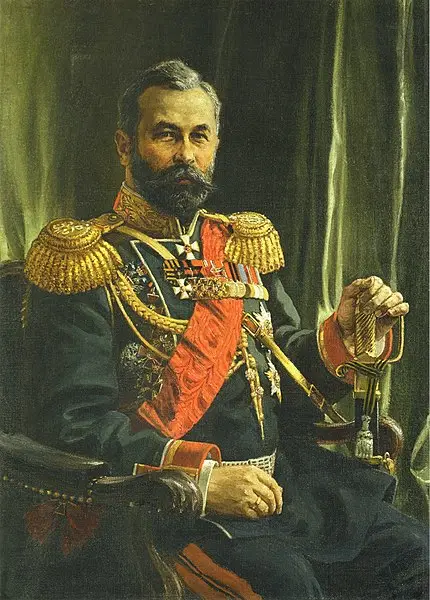
Russian military and statesman Alexey Nikolaevich Kuropatkin (1848–1925). Portrait by Vladimir Poyarkov, after 1905.
Information